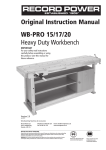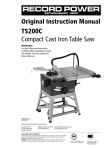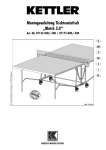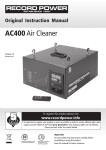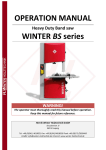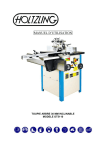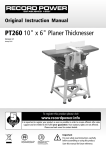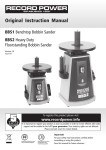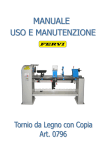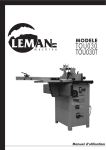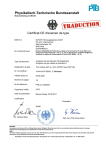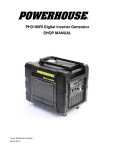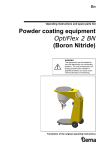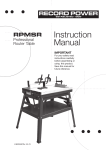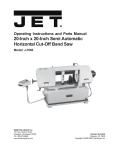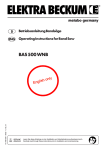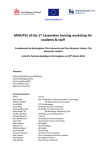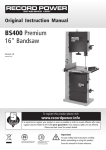Download SM100 Spindle Moulder
Transcript
Original Instruction Manual SM100 Spindle Moulder IMPORTANT For your safety read instructions carefully before assembling or using this product. Save this manual for future reference. Version 2.1 January 2011 Woodworking Machines & Accessories Record Power Ltd Unit B, Adelphi Way Staveley S43 3LS Telephone: 01246 561 520 Fax: 01246 561 537 Email: [email protected] www.recordpower.co.uk HEALTH AND SAFETY GUIDELINES Always follow the instructions provided with the manual. Always wear safety glasses when using woodworking equipment. Always disconnect the power before adjusting any equipment. Failure to observe proper safety procedures and guidelines can result in serious injury. WARNING: Do not allow familiarity (gained from frequent use of your machine and accessories) to become commonplace. Always remember that a careless fraction of a second is sufficient to inflict severe injury. Always wear safety glasses when using woodworking equipment. Always read the instructions provided before using woodworking equipment. Contents Terms & Conditions Of Usage Health & Safety Guidance page 3 Additional Safety Instructions For Spindle Moulders page 4 Record Power Guarantee page 5 EU Declaration Of Conformity page 27 User Manual 1 Specifications page 6 2 Getting to Know Your Machine page 6 3 Assembly 4 Adjustment & Operation 5 Wiring Diagram page 16 6 Maintenance page 17 7 Troubleshooting page 18 8 Parts List & Diagrams page 7 - 13 page 14 - 15 page 19 - 26 Health & Safety Guidance READ ALL THE INSTRUCTIONS IN THIS MANUAL CAREFULLY BEFORE ASSEMBLY, INSTALLATION AND USE OF THIS PRODUCT. KEEP THESE INSTRUCTIONS IN A SAFE PLACE FOR FUTURE REFERENCE. • Inspect electric cords periodically and, if damaged, have them repaired by an authorized service facility or qualified electrician. • Inspect extension cords (if used) periodically and replace if damaged. Always use properly rated extension cord with a minimum core cross section of 2.5mm2 and a maximum length of 3 metres. WARNING: When using electric tools, basic safety precautions should always be followed to reduce the risk of fire, electric shock and personal injury. 16. Disconnect Machine. When not in use, before servicing, changing blades etc. disconnect the machine from the power supply. Safe Operation 17. Never leave machine running unattended. Turn power off, do not leave machine until it comes to a complete stop. 1. Eye Protection. The operation of any power tool can result in foreign objects being thrown into your eyes, which can result in severe eye damage. Always wear safety glasses or other suitable eye protection. Wear safety glasses at all times. Everyday glasses only have impact resistant lenses. They are not safety glasses which give additional lateral protection. 2. Keep work area clear. Cluttered areas and benches invite accidents and injuries. 18. Remove adjusting keys and wrenches. ENSURE that all adjusting wrenches and keys are removed before switching the machine ‘ON’. 19. Avoid unintentional starting. Ensure the switch is in the “STOP” position before turning on the power from the main electricity supply. Your Record machine already incorporates low voltage protection. This means the machine will not automatically start up after say a power cut, unless you first reset the start switch. 3. Consider work area environment. Do not expose the machine to rain or damp conditions. • Keep the work area well lit. • Do not use the machine in the presence of flammable liquids or gases. 20. Out-door Extension Leads. Your machine should not be used outdoors. 4. Guard against electric shock. Avoid body contact with earthed or grounded surfaces. 22. Check for damaged parts. • Before use of the machine, it should be carefully checked to determine that it will operate properly and perform its intended function. • Check for alignment of moving parts, binding of moving parts, breakage of parts, mounting and any other conditions that may affect its operation. • A guard or other part that is damaged should be properly repaired or replaced by a qualified person unless otherwise indicated in this instruction manual. Have defective switches replaced by a qualified person. • Do not use the machine if the switch does not turn on and off. 5. Keep other persons away (and pets). Do not let persons, especially children, not involved in the work, touch the machine, or extension cord (if used) and keep visitors away from the work area. 6. Store idle tools. When not in use, tools should be stored in a dry, locked- up place, out of reach of children. 7. Do not force the machine. It will do the job better and work more safely if operated at the speed at which it was intended. 8. Use the right tool. • Do not force small tools to do the job of a heavy-duty tool. • Do not use tools for purposes other than those for which they were intended. 9. Dress properly. • Non-slip footwear is recommended. • Do not wear loose clothing, neckties or jewellery; they can be caught in moving parts. • Roll up long sleeves above the elbow. • Wear protective hair covering to contain long hair. 10. Use protective equipment. • Use safety glasses. (See note 1. above) • Use face or dust shield if cutting operation creates dust. • Use ear plugs or ear defenders when the machine is in use 11. Connect dust extraction equipment. 12. Do not abuse the cord. Never yank the cord to disconnect it from the socket. Keep the cord away from heat, oil and sharp edges. 13. Do not overreach. Keep proper footing and balance at all times. 14. Secure work. Ensure that your work piece is properly held before starting to cut. 21. Stay alert. Watch what you are doing, use common sense and do not use the machine when you are tired. 23. Warning! • The use of any accessory or attachment, other than those recommended in this instruction manual, or recommended by our Company may present a risk of personal injury. 24. Have your machine repaired by a qualified person. • This electric machine complies with the relevant safety rules. Only qualified persons using original spare parts should carry out repairs. Failure to do this may result in considerable danger to the user. 25. This machine is designed for planing and thicknessing wood. • Do not use this machine for any other material Maintenance and Servicing. This machine requires very little maintenance. This handbook gives clear instructions on installation, set up and operation. Read these instructions carefully. Remember always to switch off and unplug from the main electricity supply before carrying out any setting up or maintenance operations. Should you need advice on the repair or maintenance of this product, our Customer Service Department can be contacted on 01246 561 520 and will be happy to assist you. 15. Maintain tools with care. • Follow instructions for lubrication and changing accessories. 2 3 Additional Safety Instructions for Spindle Moulders WARNING: Like all power tools there is a danger associated with spindle moulders. Accidents are frequently caused by lack of familiarity or failure to pay attention. Use this tool with respect and caution to lessen the possibility of operator injury. If normal safety precautions are overlooked or ignored, serious personal injury can occur. Caution: No list of safety guidelines can ever be complete. Every shop environment is different. Always consider safety first, as it applies to your individual working conditions. Use this and other machinery with caution and respect. Failure to do so could result in serious personal injury, damage to equipment or poor work results. 1. Never allow your hands to come within 12 inches of the cutters. Never pass your hands directly over or in front of the cutter. 2. Blind cut whenever possible. This keeps the knives on the underside of the workpiece and provides a distance guard for the operator. 3. When shaping contoured work and using a rub collar, never start out at a corner. See the ‘rub collar’ instructions, further in the manual. 4. With the machine unplugged, always rotate the spindle by hand with any new set up to insure proper cutter clearance before starting the machine. 5. Do not shape stock shorter than 12 inches without special fixtures of jigs. where practical, shape longer stock and cut to size. Site Considerations General Condition: 1.Electrical connection: Steady state voltage: 0.9-1.1 of normal voltage. Frequency: 0.99-1.01 of normal frequency Continuously: 0.98-1.02 short time 2.Altitude does not exceed 1000m, Maximum ambient air temperature is +40oC, minimum ambiant air temperature is no less than +5oC, Storage and transportation temperature range is between -15oC and +55oC, The relative humidity does not exceed 50% at a maximum temperature of +40oC, higher relative humidity may be permitted at lower temperatures (e.g. 90% @ 20oC). Floor Load This machine represents a moderatly large weight load in a small footprint. Most commercial shop floors will be adequate for the weight of this machine. Some floors may require additional support. Contact an architect or structural engineer if you have any questions about the ability of your floor to handle the weight. Working Clearances 7. The danger of kickback is increased when the stock has knots, holes or foreign objects in it. Warped stock should be run through a planer/ thicknesser before attempting to run it through a spindle moulder. Working clearances can be thought of as the distances between machines and obstacles that allow safe operation of every machine without limitation. Consider existing and anticipated machine needs, size of material to be processed through each machine, and space for auxiliary stands and/or work tables. Also consider the relative position of each machine to one another for efficient material handling. Be sure to allow yourself sufficient room to safely run your machines in any forseeable operation. 8. Keep the unused portion of the cutter below the table surface. Lighting and Outlets 9. The use of push sticks as a safety device in some applications is smart: in others in can be quite dangerous. If the push stick comes in contact with the cutter on the end grain, it can fly out of your hand. Potentially causing serious injury. We recommend using some type of fixture, jig or holding device as a safer alternative. Always use the guard as described in the manual. Lighting should be bright enough to eliminate shadow and prevent eye strain. Electrical circuits should be dedicated or large enough to handle combined motor amp loads. Outlets should be located near each machine so power or extension chords are not obstructing high-traffic areas. Be sure to observe local electrical codes for proper installation of new lighting, outlets, or circuits. 10. Never force materials through the spindle moulder. Let the cutter do the work. Excessive force is likely to result in poor cutting and finishes. It will also cause dangerous kickback conditions. Dust Collector 6. Never attempt to remove too much material in one pass. You are far more likely to enjoy safer and higher quality results if you allow the cutter to remove material in multiple passes. 11. Always ensure that cutters, fence and spindle elevator knob have been tightened properly before beginning operation. 12. Always feed the work towards the cutter in the direction opposite of the cutter rotation. Also, using and maintaining a sharp cutter head will greatly reduce the chance of kickback. 13. Never reach behind the cutter to get the workpiece. Your hand may be pulled into the cutter in the event of a kickback. 14. If at any time you are experiencing difficulties performing the intended operation, stop using the machine. Then contact our service department. As a rule, this machine must be vacuumed during use. A time relay socket is available as an accessory. In addition, the vacuum performance must be sufficient to achieve the required negative pressure and a maximum air speed of 20m/sec at the connector. WARNING: Read the manual before assembly and operation. Become familiar with the machine and it’s operation before beginning any work. Serious personal injury may result if safety or operational information is not understood or followed. Record Power Guarantee 1. INTRODUCTION 1.1 We supply machinery through a network of dealers and authorised distributors and you should be aware that your contract of sale is with the retailer from whom you purchased this product. 1.2 If you are not satisfied with this product you should in the first instance approach the retailer from whom you purchased it. 1.3 Customers have statutory rights to protect them and information on this can be found at the Citizens Advice Bureau or on such web-sites as that operated by the DTI (http://www.dti.gov.uk) 1.4 Returning your guarantee card will speed up the claims procedure and can be very helpful as a proof of purchase should the initial receipt be mislaid or damaged. We recommend that this is returned as close to your original purchase date as possible. 1.5 Correct installation, set-up, adjustment and routine maintenance of the machine are the responsibility of the end-user and problems arising from incorrect set-up, adjustment or maintenance are not covered by the terms of this guarantee. However support is available in the first instance from the retailer who supplied you and free technical support is available from Record Power on 01246 561 520 during office hours and from an extensive knowledge base on our website www.recordpower.co.uk. We also recommend that those users who have not had suitable training in the safe use of machinery should seek such training locally before using or attempting to set up and adjust any machinery (please contact your retailer for recommendations in your local area). 2. GUARANTEE 2.1 In addition to the above Record Power guarantees that for a period of 5 years from the date of purchase the components of this product will be free from defects caused by faulty construction or manufacture. 2.2 During this period Record Power will repair or replace free of charge any parts which are proved to be faulty in accordance with paragraph 2.1 above provided that: 2.2.1 You follow the claims procedure set out below; 2.2.2 We are given a reasonable opportunity after receiving notice of the claim to examine the product. 2.2.3 If asked to do so by us, you return the product to Record Power's premises or other approved premises such as those of the supplying dealer, for the examination to take place. 2.2.4 The fault in question is not caused by continuous industrial use, accidental damage, fair wear and tear, wilful damage, negligence on your part, incorrect electrical connection, unapproved modification, abnormal working conditions, failure to follow our instructions, misuse, or alteration or repair of the product without our approval. 2.2.5 This product has been purchased by you and not used for hire purposes; 2.2.6 This Guarantee extends to the cost of carriage incurred by you returning the product to Record Power as long as it is demonstrated that the defect falls within the terms of this Guarantee and you follow the claims procedure as outlined below; address below on the last day of this Guarantee at the latest. Late claims will not be considered. 3.4 We will contact you once we have received your initial written claim. If it is necessary to return the item, in most cases but subject always to clause 2.2.5, we will arrange for collection or will provide freepost information to enable return depending on the weight and size of the product concerned. If the product is to be returned to us, we will agree with you in advance a Returns Number, to speed tracking of the claim and ensure the most appropriate method of return to you is used. 4. NOTICE This Guarantee applies to all goods purchased from an authorised retailer of Record Power within the United Kingdom of Great Britain and Northern Ireland. This Guarantee does not confer any rights other than those expressly set out above and does not cover any claims for consequential loss or damage. This Guarantee is offered as an extra benefit and does not affect your statutory rights as a consumer. Additional written copies of this Guarantee can be obtained by writing to the address below. Please include a stamped and self addressed envelope for each copy of the Guarantee requested. Record Power Ltd. Unit B, Adelphi Way Ireland Industrial Estate Staveley, Chesterfield S43 3LS 3. CLAIMS PROCEDURE 3.1 In the first instance please contact the retailer who supplied the product to you. In our experience many initial problems with machines that are thought to be due to faulty parts are actually solved by correct setting up or adjustment of the machines. A good dealer should be able to resolve the majority of these issues much more quickly than processing a claim under the guarantee. 3.2 If the dealer who supplied the product to you has been unable to satisfy your query, any claim made under this Guarantee should be made directly to Record Power at the address set out at the foot of this Guarantee. The claim itself should be made in a letter setting out the date and place of purchase, and giving a brief explanation of the problem which has led to the claim. This letter should then be sent with proof of the purchase date (preferably a receipt) to Record Power. If you include a phone number or email address this will help to speed up your claim. 3.3 PLEASE NOTE that it is essential that the letter of claim reaches the 4 5 1. Machine Specification Motor Power: 230V~ 50Hz 2800W Motor Speed: 2800rpm Table Size: 480 x 690mm Table Height: 900mm Spindle Diameter: 30mm Spindle Travel: 100mm Table Opening: 200mm Table Height: 900mm Table Ring: 200mm maximum Tool diameter: 200mm Speeds: 1800/3000/6000/9000rpm Extraction connector diameter: 100mm 2. Getting to Know Your Machine Feeder Assembly Safety Guard Feed Roller Extractor Connector Table Main Switch (No-volt Release) Spindle Height Adjustment Handwheel Spindle Speed Display Spindle Height Display Machine Housing Workstand 3. Assembly Unpacking The spindle moulder is shipped from the manufacturer in a carefully packed carton. If you discover the machine is damaged in any way, please contact your dealer or our customer service department immediately. After all the parts have been removed from the carton, you should have: Spindle Moulder Machine Housing Assembly Workstand panel x 4 Column x 4 & hardware (1 bag) Safety Guard Assembly Feeder Assembly Fence Extrusion x 2 Tools & Hardwares Most of your spindle moulder has been assembled at the factory, but some parts must be assembled or installed after delivery. We have organized the assembly process into steps. Please follow in the order presented in this section. Installing the Work Stand 1, Take 4 panels and 4 columns from main carton. 2, Take the following hardware from the workstand hardware bag. 16-Hex head screw M8x20 32-8mm Flat washer 16-Hex Nut Fig. 3.1 3, Assemble the work stand as shown in Fig. 3.1. Installing the Machine Housing Onto Work Stand WARNING: Do not lift the machine housing without help. This machine housing is over 70Kg, always seek assistance before attempting to lift the machine. Fig. 3.2 1, Place the machine housing over the thread holes on the work stand. 2, Loosen 2 Star type screw to open the machine housing door and remove 6 x Allen Bolt to the sidepanel. 3, Take the following hardware from the workstand hardware bag. 4 x Hex head screw M8x20 8-8mm Flat washer 4 x Hex Nut 4, Secure all screws as shown in Fig. 3.2. 6 7 Installing the Cutting Tools CAUTION: Install tool on the spindle as low as possible. It should turn freely in the lowest spindle position. Make sure that tool does not make contact with the table ring or fence extrusion. Danger of Personal Injury! Form a habit of turning the tool by hand before switching machine on to be sure tool runs clear. Fig. 3.3 1, Lay the table ring flat into table plate. The table ring, when mounted, should not stand out over the table surface, in order to allow workpiece to be pushed smoothly over the table surface. When doing milling work with a raising cutter, take the table ring out of the table. 2, Position the moulding tool with the spindle ring onto the spindle and secure the lock flange with Allen bolt M12x25 (Fig. 3.3). 3, Adjust the moulding tool height on the shaft, using other thickness spindle ring or rings. The thickness of the spindle ring supplied are 30, 25, 15, 10, 5, 2 & 1 mm. Installing the Safety Guard Fig. 3.4 Safety guard 1, Place the safety guard over the threaded holes on the table. 2, Insert the ratchet lever M8x150 with a 8mm large washer into the safety guard as shown in Fig. 3.4, and thread the ratchet lever clockwise to secure to the table. 3, Slide the fence extrusion onto the fence extrusion carriage, and secure it. 4, To align the fence extrusion, adjust one or both fence so they are in close alignment. Check the alignment with a straightedge as shown in Fig. 3.5. Ratchet Lever Fence extrusion Fig. 3.5 Installing the Feeder Assembly 1, Insert the feeder arm into feeder base and secure it with star type screw M8x25. 2, Place the Feeder Assembly and Anti-kickback Assembly onto the Feeder Arm and secure it. Fig. 3.6 Feed roller assembly Star type screw Feeder arm Feeder base Anti-kickback assembly Installation of the Optional Sliding Carriage 1. To begin installation of the sliding carriage firstly start by attaching the carriage support strut to the machine body via the securing brackets located on the body of the machine (Fig. 3.7). Fig. 3.7 Securing Brackets Machine Body 2. To do this use the two sets of three nuts, two washers and one bolt combinations already attached to the carriage support struts (Fig. 3.8). 3. Screw the first bolt into the top hole of the securing bracket. 4. Wind on nuts A and B followed by washer A, then the carriage support strut, washer B and finally nut C (Fig 3.8). Fig. 3.8 Washer A Securing Bracket Nut A Nut B Washer B Nut C Carriage Support Strut 5. For the lower hole of the securing bracket repeat step 4 but leave out washer B as the carriage support strut height adjustment washer is used in its place (Fig. 3.9). Fig. 3.9 Height Adjustment Washer Carriage Support Strut 6. To attach the carriage to the support struts position the T-slots, located on the back of the carriage, in line with the fixing bolts (Fig. 3.10). 7. Feed the T-slots onto the fixing bolts and secure in place once in the desired position. Fig. 3.10 T-Slots Fixing Bolts Carriage Support Strut PLEASE NOTE: The carriage can be positioned according to user requirements such as: length of workpiece, position and location in the workshop or user preference (Fig. 3.11). Fig. 3.11 8 9 8. To attach the table to the carriage simply remove one of the stops at either end of the carriage using a 5mm Allen Key (Fig. 3.12). Fig. 3.12 Table Stop Carriage 9. Now slide the pre assembled table and table rollers onto the carriage, making sure all six runners are in contact with the carriage and re-attach the stop. The table should move freely and smoothly along the carriage (Fig. 3.13). 5mm Allen Key Fig. 3.13 Table Rollers Carriage Fine Adjustment of the Optional Sliding Carriage Now the table is attached to the carriage some fine adjustment may be required to position the sliding table parallel to the table of the spindle moulder machine. There should be a space of 2 to 3mm between the two tables. The sliding table should also be approximately 1mm higher than the spindle moulder table. Fig. 3.14 Washer B Upper Nut C Upper Nut B Upper Nut A 1. To adjust the space between the two tables tighten or loosen the upper nuts B and C of the two carriage support struts using a 13mm spanner (Fig. 3.14). By loosening upper nut B then tightening upper nut C it will result in changes of the verticle angle of the tabe and will be most noticible at the furthest end of the sliding table. 2. To adjust the height of the sliding table tighten or loosen the lower nut D of the carriage support struts (Fig. 3.15). This will push the carriage support strut higher or lower in relation to the spindle moulder table. Washer A Securing Bracket Carriage Support Strut Fig. 3.15 Carriage Support Strut Securing Bracket Please Note: The sliding table should be adjusted so that both the distance between the two tables and the height above the spindle moulder table, remain constant (Fig. 3.16) as the sliding table is moved along the length of the carriage. Failure to adjust the table correctly will result in poor quality, inaccurate cuts. Fig. 3.16 Lower Nut D Space Between Table Machine Table 90º Angle Sliding Table Installation of the Mitre Gauge Onto the Optional Sliding Carriage 1. Position the mitre gauge on the sliding table so that the two threaded holes (on the side of the table) and the larger threaded hole (on the top of the table) line up with the corresponding fixings of the mitre gauge body (Fig. 3.17). Fig. 3.17 Large Threaded Hole Sliding Table Smaller Threaded Holes Carriage 2. Now secure the mitre gauge in position by firstly placing and tightening the two allen key screws through the gauge and into the corresponding screw holes in the table. Access can be obtained through pre-drilled holes on the outside of the mitre gauge (Fig. 3.18). Please Note: Do not over-tighten the allen key screws initially as some movement in the gauge will be required for the next step. Fig. 3.18 Mitre Gauge Access Hole Sliding Table Allen Key 3. To secure the larger bolt place it through the hole in the top of the mitre gauge and into the corresponding screw holes in the sliding table. Once this bolt is in place the smaller allen key bolts can be tightened to secure the mitre gauge into place (Fig. 3.19). Allen Key Screw Fig. 3.19 Large Bolt Sliding Table Mitre Gauge 4. Micro adjustment can be made when using the mitre gauge by simply turning the two eccentric bolts located on either side of the cam lock. Use the bolt located to the left of the cam lock for adjustment at 90º and the bolt located to the right of the cam lock for adjustment at 45º (Fig. 3.20). Fig. 3.20 90º Fine Adjustment Knob 45º Fine Adjustment Knob Cam-Lock 10 11 Installation of the Fence Onto the Optional Sliding Carriage 1. Align the T-slot on the fence extrusion with the metal runners attached to the mitre gauge (Fig. 3.21). 2. feed the fence along the metal runners until in the desired position. Fig. 3.21 Mitre Gauge Metal Runners Sliding Table 3. Tighten with a 5mm allen key to hold in position (Fig. 3.22). Fig. 3.22 Fence 5mm Allen Key Mitre Gauge Installation of the Flipover Stop Onto the Optional Sliding Carriage 1. Slide the flipover stops metal runner into the T-slot of the fence and tighten the locking handle (Fig. 3.23). Your flipover stop is now secure. Fig. 3.23 Locking Handle Fence Flipover Stop T-Slot 2. Fine adjustment can be made to the flipover stop simply by turning the adjustment knob (Fig. 3.24). Fig. 3.24 Locking Handle Flipover Stop Fence Adjustment Knob Installation of the Work Clamp Onto the Optional Sliding Carriage The work clamp can be positioned in two places on the table depending on if you are using the fence at 90º or 45º (Fig 3.25) Fig. 3.25 Mitre Gauge Fence To secure the work clamp in to position simply screw the height adjustment bar into the 90º or 45º hole (Fig. 3.26, Fig 3.27) 45º Position 90º Position Table Fig. 3.26 90º Position Fig. 3.27 45º Position Clamping Work in Position Fig. 3.28 1. To hold your work in place using the work clamp loosen the height adjustment knob (Fig. 3.28). 2. Slide the work clamp down the height adjustment bar until it comes in contact with the wood. 3. Tighten the height adjustment knob. 4. Lift up the clamp handle until there is adequate pressure on the work piece. 5. Your work piece is now secure and ready to be machined. Work Piece Clamp Handle Height Adjustment knob Height Adjustment Bar 12 13 4. Adjustment & Operation CAUTION: Read the manual before assembly and operation. Become familiar with the machine and its operation before beginning any work. Serious personal injury may result if safety or operational information is not understood or followed. WARNING: Before you perform this adjustment switch off the power first. Fig. 4.1 A Speed Changes This machine is equipped with a V-belt drive system that controls the speeds. To change spindle speeds: 1. Unplug the machine. 2. Loosen the two Star type Screw M6 x 30, open the Machine Housing Door. 3. Loosen the Allen Bolt M12 x 40 (Fig. 4.1 a) with allen wrench, Pull the Motor Tension Lever (Fig. 4.1 b) out. 4. Select the desired speed. 1800 R.P.M., 3000 R.P.M., 6000 R.P.M., 9,000 R.P.M. Fig. 4.2 shows the belt positions for each available speed. 5. Align the belt along the appropriate pulley grooves 6. Push up the Motor Tension Lever (Fig. 4.1 b) and tighten the Allen Bolt When the belt is properly tensioned, there should be approximately 1⁄4” of deflection in the center of the belt when you press it with moderate pressure. 7. Tighten all the adjusting bolts. 8. Spin the pulley by hand to ensure proper tracking. 9. Close the door. B Fig. 4.2 1800rpm 3000rpm 6000rpm 9000rpm Fig. 4.3 Adjust the Height of the Spindle 1. Loosen the Spindle Height Lock A (Fig. 4.3). 2. Make sure the fence & table are clear of the moulding tool. 3. Move the spindle up or down with the Spindle Height Handwheel B (Fig. 4.3) until the desired position is obtained. To raise = turn counter-clockwise To lower = turn clockwise 4. Secure the Spindle Height Lock A (Fig. 4.3). A B C Fence Adjustment Fig. 4.5 The fence is a two-piece adjusting system. Each fence is independently adjustable to compensate for different cutting thicknesses and special moulding applications. To adjust the fence: 1. Loosen the fence lock handle Star type Screw M8 x 25 (Fig. 4.5 a) 2. Turn the Spindle Setting Knob (Fig. 4.5 b) until the fence is set to the desired position. 3. Tighten the fence lock handle (Fig. 4.5 a). WARNING: Perform this adjustment only when the spindle and moulding tool are at a standstill. B A Adjust the Feed Roller Fig. 4.6 1. Loosen the Star type Screw M8x25 A and B (Fig. 4.6). 2. Move the Feed Roller above the workpiece. 3. Lock the Star type Screw M8x25 A (Fig. 4.6), position the feed roller on the center line of workpiece. 4. Lock the Star type Screw M8x25 B (Fig. 4.6), secure the roller as close as possible to workpiece. 5. Loosen the Star type Screw M8x25 C and D (Fig. 4.6). 6. Move the Anti-kickback Plate near the workpiece. 7. Lock the Star type Screw M8x25 C (Fig. 4.6) 8. Lock the Star type Screw M8x25 D (Fig. 4.6), ensure that the plate is as close as possible to the work piece. Sanding CAUTION: To perform this operation, the spindle speed should be at 1800rpm maximum. 1. Remove the Safety Guard and Feed Roller. 2. Adjust the spindle to Highest Position. 3. Insert the Sanding Drum A to Sanding Sleeve B (Fig. 4.7). 4. Place Support Disc C (Fig. 4.7) and Sanding Drum Assembly onto spindle 5. Secure the Lock Flange D (Fig. 4.7) with Allen Bolt M12 x 25 E (Fig. 4.7). A C WARNING: Before performing this adjustment, switch off the power first. B D Fig. 4.7 E D C B A C 14 15 5. Wiring Diagram The electric motor is designed for the S6 40% operating mode. And the motor is equipped with a thermal protect system, therefore the motor is automatically switched off in the event of an overload. The motor can be switched on again after a cooling down period that can vary. Electrical connection cables often suffer insulation damage. Such defective electrical connection cable must not be used as the insulation damaged makes them extremely hazardous. Check electrical connection cables regularly for damage. Make sure the cable is disconnected from the mains when checking. Once the machine has been correctly assembled and set up the electricity supply can be connected. The machine can only be connected to a single phase supply. Before connecting the electrical supply ensure that it is the correct voltage, phase and frequency, and that it has sufficient capacity for the machine. The relevant information can be found on the rating plate located on the rear of the machine. Machines supplied for use in the UK are fitted with a BS1363 plug fitted with a 13 amp fuse. Ensure that you use the appropriate plug for use in other countries. If the plug fitted to the machine is changed for any reason, the wires in the mains lead are coloured in accordance with the following code: Green and yellow: Blue: Brown: Earth Neutral Live As the colours of the wires in the mains lead may not correspond with the coloured markings identifying the terminals on your plug, proceed as follows: The wire coloured green and yellow must be connected to the terminal marked ‘E’ or by the earth symbol ~ or coloured green; or green and yellow. The wire coloured blue must be connected to the terminal marked ‘N’ coloured black. The wire coloured brown must be connected to the terminal marked ‘L’ or coloured red. IT IS IMPORTANT THAT THE MACHINE IS EFFECTIVELY EARTHED. If in doubt about the connection of the electrical supply consult a qualified electrician. RCD (Residual Current Device) For your additional safety we always recommend the use of an RCD (sometimes called Residual Current Circuit Breaker or Earth Leakage Circuit Breaker). 5. Maintenance NOTE: Always switch off the motor and disconnect the plug from the power supply prior to any maintenance and cleaning work. Before operation: 1, Visually check distance which is 3-8mm,between the moulding tool and fence extrusion, between moulding tool and table. 2, Visually check of power cable and power cable plug for damage; if necessary have damage parts replaced by a qualified electrician. General maintenance: Check for the following conditions and repair or replace when necessary. 1. Loose mounting bolts. 2. Worn switch. 3. Worn or damaged cords and plugs. 4. Damaged V-belt. 5. Any other condition that could hamper the safe operation of this machine. Table Tables can be kept rust-free with regular applications of silicone based wax or silicone rich spray (CWA195). Lubrication The only parts on this machine that require periodic lubrication are the ways where the cartridge slide rides on the machine housing and where the worm gear and bushing are located. Use a light grease or anti-seizing compound on the ways and worm gear, and give the shaft mount a shot of light oil. V-Belt Avoid getting grease or oil on the V-belt or pulleys. Check the V-belt, as part of a monthly inspection for proper tension and belt condition. Cracking and glazing could result in belt failure. Replace the belt if such conditions appear. Schedule Regularly blow out air vents with compressed air and keep the exhaust port clear. NOTE: If using compressed air always wear safety goggles and a dust mask. For every 1 hour of use, clean and wipe down with light grease: Table and miter gauge slide Fence faces For every 5 hours of use, clean and oil: Spindle column and cartridge Offset adjustment mechanisms on fence All worm drive and other gears Once a year, replace the V-belt, or as and when worn. 16 17 5. Troubleshooting Before carrying out any fault service or maintenance work always: Switch machine OFF Unplug power cable Wait for spindle moulder to come to standstill. Problem Cause Solution Motor is slow or weak Voltage from source is low. Windings are burned out or open. Power switch is defective. Circuit is overloaded with appliances lights, or other electrically powered equipment. Request a voltage check from local power company. Have the motor checked / repaired. Have the power switch replaced. Do not use other appliances or electrically powered equipment on the same circuit when using the table saw. Motor overheats Motor is overloaded. Dull moulding tool. Request a voltage check from the local power company. Replace the moulding tool When moulding, the cut burns the workpiece, or stalls the motor. Moulding tool is dull. Work-piece is warped. Sharpen or replace the moulding tool. Replace the work-piece. Height Handles are hard to turn. Dust has collected on the mechanisms inside the base. Clean and lubricate the mechanisms inside the base. Spindle moulder vibrates excessively. Floor surface is uneven. V-belt is damaged. Moulding tool is damaged. Loose bolt, screws, nuts. Readjust the levelling feet. Replace the v-belt. Replace the moulding tool. Tighten all hardware. Spindle moulder does not start. Motor cord is not plugged in. Circuit fuse is Plug in motor cord to volt electrical outlet. blown. Circuit breaker is tripped. Motor cord Replace circuit fuse. Reset circuit breaker. Have or switch is damaged. the motor cord or switch replaced. Power switch does not operate. Power switch contacts are burned out. Capacitor is defective. Wiring connections are loose or damaged. Have the power switch replaced. Request a voltage check from the local power company. Have the capacitor replaced. Have the wiring connections checked / repaired. Fuses or circuit breakers open frequently Motor is overloaded. Fuses or circuit breakers are wrong size or defective. Dull moulding tool. Power switch is defective. Feed work-piece more slowly. Replace fuses or circuit breakers. Replace the moulding tool. Have the power switch replaced. Motor stalls, blows fuses, or trips circuit breakers. Motor is overloaded. Dull milling tool. Fuses or circuit breakers are wrong size or defective. Feeding work-piece too rapidly. Request a voltage check from the local power company. Replace the moulding tool. Replace fuses or circuit breakers. Feed work-piece more slowly. Spindle moulder is noisy when running. Motor is loose or defective. Have the Motor checked/repaired Warning: To prevent personal injury and/or damage to the spindle moulder, maintenance and repairs should be done only by a qualified technician. 6. Parts Lists & Diagrams No. A-1 A-2 A-3 A-4 A-5 A-6 A-7 Description Spindle shaft Spindle ring F50x30x30mm Spindle ring F50x30x15mm Cutting tool Lock flange Allen bolt M12x25 Wrench 45mm Quantity 1 1 1 1 1 1 1 No. A-8 A-9 A-10 A-11 A-12 A-13 A-14 Description Allen wrench 10mm Starknob screw M8x25 Spindle ring F50x30x25mm Spindle ring F50x30x10mm Spindle ring F50x30x5mm Spindle ring F50x30x2mm Spindle ring F50x30x1mm Quantity 1 3 1 1 1 1 2 18 19 6. Parts Lists & Diagrams - Cont. No. B-1 B-3 B-4 B-5 B-6 B-7 B-8 B-9 B-10 B-11 B-12 B-13 B-14 B-15 B-16 B-17 B-18 B-19 B-20 B-21 B-22 B-23 B-24 B-25 Description Table Table ring 200/150mm Table ring 150/110mm Table ring 110/80mm End cap, fence Carriage bolt, M8x40 Guide, bolt Fence extrusion Countrsunk head screw M8x20 Fence extrusion carriage Star type nut Safety guard Starknob M8x25 Ratchet lever M8x150 Lock spacer Dust outlet Cross recessed pan head screw M5x12 Lock piece, handle Guide spindle, spindle latch Hex nut M5 Setting knob, spindle latch Large washer Cover, safer guard Starknob screw M8x25 Quantity 1 1 1 1 2 2 2 2 2 2 2 1 8 2 2 1 6 2 2 2 2 2 1 3 No. B-26 B-27 B-28 B-29 B-30 B-31 B-32 B-33 B-34 B-35 B-36 B-37 B-38 B-39 B-40 B-41 B-42 B-43 B-44 B-45 B-46 B-47 B-48 B-49 Description Feeder base Block, feeder base Roll pin 3x10 Allen bolt M8x20 Flat washer 8mm Spring washer 8mm Allen bolt M8x25 End cap, feeder arm Feed arm Insert, feed arm Feeder joint Rod, roller Rod, roller Plate, anti-kickback Pin, roller Spring washer 8mm Hex nut M8 Roller frame Roller house Hex head screw M6x35 Plate spring Lock nut M6 Roller bushing Roller Quantity 1 1 5 2 4 6 4 2 1 2 2 2 2 1 6 2 2 1 3 3 3 3 3 3 6. Parts Lists & Diagrams - Cont. 20 21 6. Parts Lists & Diagrams - Cont. No. C-2 C-3 C-4 C-5 C-6 C-7 C-8 C-10 C-11 C-12 C-13 C-19 C-20 C-21 C-22 C-23 C-29 C-30 C-32 C-33 C-34 C-37 C-38 C-39 C-40 C-41 C-42 C-43 C-44 C-45 C-46 C-47 C-48 C-49 C-50 C-51 C-52 C-53 Description Spring washer 10mm Dust outlet Cross recessed pan head screw M4x10 Hex head bolt M10x30 Allen bolt M10x40 Spindle housing Spring Scale wire mount Countersunk head screw M4x6 Spring washer 8mm Allen bolt M8x25 Cup, Spindle guide tube Allen bolt M4x16 Spring washer 4mm Ball bearing 80106 Spindle guide tube Circle 24mm Hex head screw M8x20 Countersunk head screw M5x12 Large washer 6mm Wheel handle Flat key 4x4x12 Spindle shaft Flat key 8x8x25 Lock nut M30 Set screw M6x8 Spindle pulley Large washer 10mm Allen bolt M10x20 Allen bolt M12x40 Hex nut m16 Flat washer 16mm Mount, motor Special nut, 24mm Hex head screw M12x40 Motor pulley Flat key 8x8x40 Joint, tension Quantity 15 1 4 4 8 1 2 1 2 16 12 2 8 8 2 1 1 1 1 1 1 1 1 1 1 1 1 3 2 1 1 1 1 1 1 1 1 1 No. C-54 C-55 C-56 C-57 C-58 C-59 C-60 C-61 C-62 C-63 C-64 C-65 C-66 C-67 C-68 C-69 C-70 C-71 C-72 C-73 C-74 C-75 C-76 C-77 C-78 C-79 C-80 C-81 C-82 C-83 C-84 C-85 C-86 C-87 C-88 C-89 C-90 C-91 Description Hex nut M10 Thread, tension Lever, tension Lock nut M10 Motor Flat washer 12mm Spring washer 12mm Allen bolt M12x30 Thread, joint Joint, motor tension Lock nut M10 Guide bar End stop, guide Allen bolt M10x15 Cross recessed pan head screw M4x12 Lock lever, rise Spring, lock lever Pear plate, lock lever Cross recessed pan head screw M4x6 Flat washer 4mm Pointer Allen bolt M6x25 Bushing, pointer Bracket, pointer Housing, rise shaft Rise shaft Rising spindle Flat key 6x6x14 Carrier, rise gear Worm Bushing, worm Ball bearing 80202 Roll pin 4x20 Gear-helical Thrust bearing 8105 Bushing, spindle Special washer Thin hex nut M20 Quantity 3 1 1 1 1 1 1 1 1 1 1 1 1 2 1 1 1 1 1 1 1 1 1 1 1 1 1 1 1 1 1 1 1 1 1 1 1 2 6. Parts Lists & Diagrams - Cont. No. Description D-1 D-2 D-3 D-4 D-5 D-6 D-7 D-8 D-9 D-10 D-11 D-12 D-13 D-14 D-15 D-16 D-17 D-18 D-19 D-20 D-21 Hex nut M10 Set screw M10x70 Flat washer 6mm Allen bolt M6x30 Left panel, machine housing Left frame, machine housing Hex Nut M8 Flat washer 8mm Hex head screw, M8x20 Rear panel, machine housing Beam, machine housing Right frame, machine housing Open door, machine housing Star type screw M6x30 Box, switch Display assembly Seal Panel, switch Main switch (No volt release) Turning switch Cross recessed sunk head screw M4x10 Quantity 12 4 8 6 1 1 38 114 38 1 1 1 1 2 1 1 1 1 1 1 2 No. Description D-22 D-23 D-24 D-25 D-26 D-27 D-28 D-29 D-30 D-31 D-32 D-33 D-34 D-35 D-36 D-37 D-38 D-39 D-40 D-41 Pan head tapping screw M4x10 Pan head tapping screw M4x30 Front panel, machine housing Scale holder Spring Scale Nut scale Hex nut M4 Wire scale Wire holder Cross recessed sunk head screw M4x10 Cross recessed tapping screw M4x10 View glass Cross recessed pan head screw M4x10 Column A Rear panel, workstand Column B Side panel, workstand Column C Front panel, workstand Quantity 2 4 1 2 1 1 1 1 1 1 1 4 1 4 1 1 1 2 2 1 22 23 6. Parts Lists & Diagrams - Cont. No. Description F-1 F-2 F-3 F-4 F-5 F-6 F-7 F-8 Flat washer 16mm Castor Roll pin Fork, castor Allen bolt M12x50 Adjustable U-shape bracket Flat washer 14mm Hex head screw M10x70 Quantity No. Description 12 4 6 2 2 2 2 2 F-9 F-10 F-11 F-12 F-13 F-14 F-15 Flat washer 10mm Sleeve Rear castor frame Hex head screw M10x20 Lever, Wheel kit Special thread Pin, castor Quantity 4 2 1 2 1 1 2 6. Parts Lists & Diagrams for Optional Sliding Carriage 24 25 6. Parts Lists & Diagrams for Optional Sliding Carriage No. Description 1 2 3 4 5 6 7 8 9 10 11 12 13 14 15 16 17 18 19 20 21 22 23 24 25 26 27 28 Bearing Support, Sliding Rail Sliding Table Support, Sliding Table Guide Fence Rail End Stop, Guide Fence Rail Sliding Rail Guide Fence Socket Screw M8x50mm Nut M8 Nut M8 8” Diameter Washer Bolt Base, Bearing Pivot, Mitre Gauge Mitre Gauge Base, Mitre Gauge Thumb Screw M6x25mm Workpiece Clamp Cam Lever Pin Holder Rod Spring Pulling Rod Allen Bolt M6x25mm 6” Diameter Washer Hex. Nut M6 Quantity 6 2 1 1 1 1 1 1 4 1 13 3 2 3 1 1 1 1 1 1 1 1 1 1 16 8 1 3 No. Description 29 30 31 32 33 34 35 36 37 38 39 40 41 42 43 44 45 46 47 48 49 50 51 52 53 54 55 56 Hex. Nut M6 Spring Washer 6” Diameter Hex. Nut M10 Washer 10” Diameter Allen Bolt M10x40mm Allen Bolt M6x20mm Allen Bolt M8x20mm Adjusting Handle M6 Flower Handle Holder Knob Washer 5” Diameter Allen Bolt M5x10mm Circle Ring Square Nut Roll Eccentric Bushing Hex. Bolt M6x30mm Washer 8” Diameter Washer 6” Diameter Intermediate Plate Carriage Bolt M6x36mm Bolt Guide Folding Stop Washer 6” Diameter Bushing Ratchet Leaver M6 End Cap Quantity 12 4 4 4 2 2 1 1 1 1 1 1 1 2 2 2 2 4 2 1 1 1 1 1 1 1 1 1 EU Declaration of Conformity Cert No: EU / SM100 / 1 RECORD POWER LIMITED, Unit B, Ireland Industrial Est. Adelphi Way, Staveley, Chesterfield S43 3LS declares that the machinery described: 1. Type: Spindle Moulder 2.Model No: SM100 3. Serial No ......................................................................... Conforms with the following directives: MACHINERY DIRECTIVE 2006/42/EC LOW VOLTAGE DIRECTIVE 2006/95/EC ELECTROMAGNETIC 2004/108/EC COMPATIBILITY DIRECTIVE EN 55014-1:2006 EN 61000-3-2:2006 EN 61000-3-3:1995+A1+A2 EN 55014-2:1997+A1 and conforms to the machinery example for which the EC Type-Examination Certificate No. BM50170155, AN50170154 has been issued by TUV Rheinland LGA Products GmbH at: Tillystrasse 2, D90431 Nürnberg and complies with the relevant essential health and safety requirements. Signed...............................................................Dated: 01/06/2010 Andrew Greensted Managing Director 26 27 Visit www.recordpower.co.uk for the full range of Record Power products. Woodworking Machinery Blades Craft Accessories Finishes and Waxes DVDs Accessories rning Woodtuiques Techionnto Spindle Turning ing urn odt cts Wo Projtlee Clock n Ma by by ltham Alan Ho Step by Step Guide Finishing on the by Lathe Alan Holtham ham olt nH Ala uct An Introd Buyer’s Guide n with In associatio Series In association with ith w tion socia In as The essential guides to the most popular ranges of woodwo rking machinery Woodworking Machines & Accessories Record Power Limited Unit B, Adelphi Way Ireland Industrial Est. Staveley S43 3LS Telephone: 01246 561 520 Facsimile: 01246 561 537 Email: [email protected] www.recordpower.co.uk




























